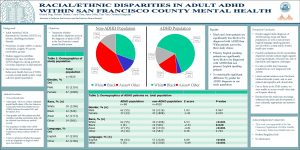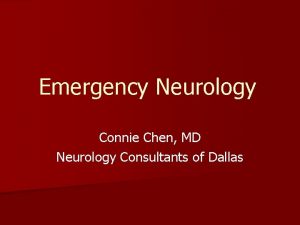Richard Feng Melanie Thomas Connie Chen James Dilley

- Slides: 1

Richard Feng, Melanie Thomas, Connie Chen, James Dilley, Thao Tran, Christina Mangurian University of California, San Francisco and San Francisco General Hospital Non-ADHD Population Background: Objectives: • Adult Attention Deficit Hyperactivity Disorder (ADHD) is a chronic, disabling psychiatric disorder • Determine whether racial/ethnic disparities exist in the diagnosis of adult ADHD in the San Francisco county mental health system • Prevalence of adult ADHD is similar worldwide, roughly 4% across racial/ethnic groups. • Studies suggest racial/ethnic disparities in rates of pediatric ADHD diagnosis, raising questions of similar disparities in adult patients • San Francisco Community Behavioral Health Services (CBHS), a county mental health system, treats a diverse patient population Methods/Procedures: Total population Gender, % (n) n=4020 Male 52 (2116) Female 47 (1898) White 63% Other 15% Asian 43% Black 12% White Black Asian Other Asian 17% Black 4% White Black Asian Other Results: Discussion/Conclusion: • Black and Asian patients are significantly less likely to be diagnosed with ADHD than White patients across the three study clinics • Results suggest under diagnosis of ADHD among Asian and Black populations, as well as non primary English language speaking patients, served within a county public mental health care system. • Primary English speaking patients are significantly more likely to be diagnosed with ADHD than non primary English speaking patients • Possible explanations for the racial/ethnic disparities include cultural stigma against receiving treatment, clinician bias, lack of familiarity and linguistic challenges. • No statistically significant difference by gender for ADHD diagnosis in our study population Table 2: Demographics of ADHD patients vs. total population • Adults aged ≥ 18 at one of three outpatient mental health clinics of the San Francisco Community Behavioral Health Services (CBHS) between November 2013 and November 2014. Race, % (n) • Demographic and other patient-specified variables, including racial/ethnic data, will be collected from electronic medical records • T-tests to determine whethere appear to be any disparities in diagnosis based upon race/ethnicity. White 31% Table 1: Demographics of study population • Cross-sectional study • The population of adults with ADHD (n=88) will be characterized and compared to patients at clinics without ADHD (n 4020) Other 14% ADHD Population White 30 (1208) Black 12 (520) Asian 42 (1713) Other 14 (581) Language, % (n) English Other 57 (2320) 42 (1700) Gender, % (n) Male Female Race, % (n) White Black Asian Other Language, % (n) English Other ADHD population n=88 non-ADHD population Z-score n=4020 P-value 62 (55) 37 (33) 52 (2116) 47 (1898) 0. 067 0. 070 62 (55) 4 (4) 17 (15) 15 (14) 30 (1208) 12 (520) 42 (1713) 14 (581) 1. 83 -1. 81 6. 53 -2. 33 -4. 81 0. 38 <0. 001 0. 020 <0. 001 0. 704 • It is also possible that Caucasian populations are over diagnosed with ADHD. • Limits include reliance on an Electronic Medical Records system, and on user entered demographic and clinical data. • Due to limits in the EMR system, we were unable to access overall clinic data on Hispanic ethnicity • Results from this study may encourage enhanced education and development of more culturally appropriate and sensitive care. Acknowledgements/Contact Info: • This work was supported by the San Francisco Department of Public Health, Community Behavioral Health Services • Richard. feng@ucsf. edu 94 (83) 5 (5) 57 (2320) 42 (1700) 6. 89 -6. 89 <0. 001 • No disclosures

